Refer to the scenario.
A customer has an AOS10 architecture that is managed by Aruba Central. Aruba infrastructure devices authenticate clients to an Aruba ClearPass cluster.
In Aruba Central, you are examining network traffic flows on a wireless IoT device that is categorized as “Raspberry Pi” clients. You see SSH traffic. You then check several more wireless IoT clients and see that they are sending SSH also.
You want an easy way to communicate the information that an IoT client has used SSH to Aruba ClearPass Policy Manager (CPPM).
What step should you take?
You are working with a developer to design a custom NAE script for a customer. You are helping the developer find the correct REST API resource to monitor.
Refer to the exhibit below.
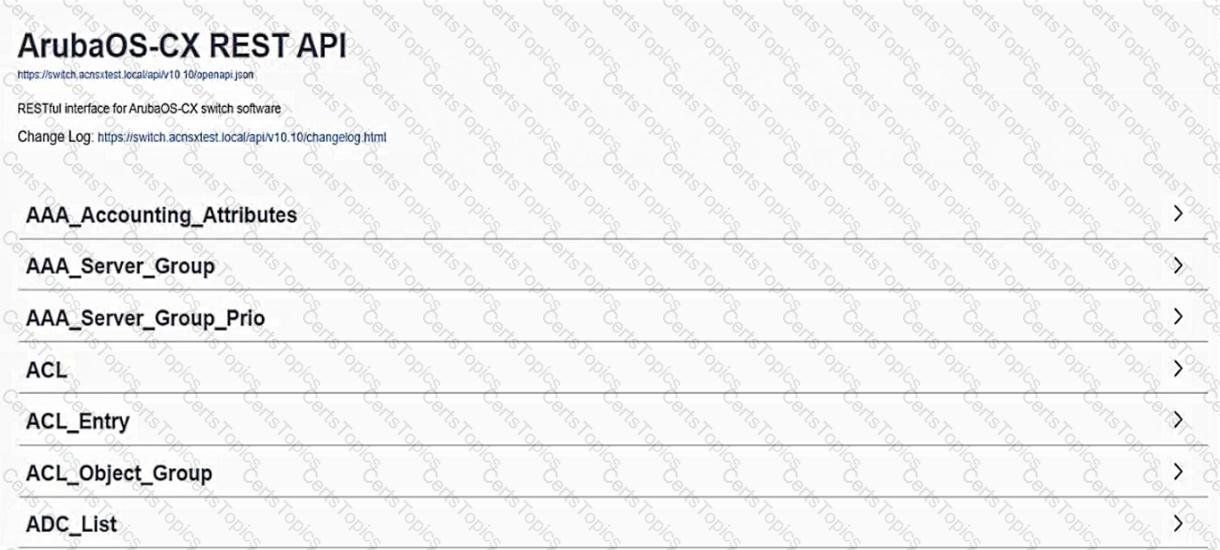
What should you do before proceeding?
You are setting up Aruba ClearPass Policy Manager (CPPM) to enforce EAP-TLS authentication with Active Directory as the authentication source. The company wants to prevent users with disabled accounts from connecting even if those users still have valid certificates.
As the first part of meeting these criteria, what should you do to enable CPPM to determine where accounts are enabled in AD or not?
A company has Aruba gateways that are Implementing gateway IDS/IPS in IDS mode. The customer complains that admins are receiving too frequent of repeat email notifications for the same threat. The threat itself might be one that the admins should investigate, but the customer does not want the email notification to repeat as often.
Which setting should you adjust in Aruba Central?
Refer to the scenario.
An organization wants the AOS-CX switch to trigger an alert if its RADIUS server (cp.acnsxtest.local) rejects an unusual number of client authentication requests per hour. After some discussions with other Aruba admins, you are still not sure how many rejections are usual or unusual. You expect that the value could be different on each switch.
You are helping the developer understand how to develop an NAE script for this use case.
You are helping a customer define an NAE script for AOS-CX switches. The script will monitor statistics from a RADIUS server defined on the switch. You want to future proof the script by enabling admins to select a different hostname or IP address for the monitored RADIUS server when they create an agent from the script.
What should you recommend?
A company has Aruba gateways and wants to start implementing gateway IDS/IPS. The customer has selected Block for the Fail Strategy.
What might you recommend to help minimize unexpected outages caused by using this particular fall strategy?
Refer to the scenario.
A customer has an Aruba ClearPass cluster. The customer has AOS-CX switches that implement 802.1X authentication to ClearPass Policy Manager (CPPM).
Switches are using local port-access policies.
The customer wants to start tunneling wired clients that pass user authentication only to an Aruba gateway cluster. The gateway cluster should assign these clients to the “eth-internet" role. The gateway should also handle assigning clients to their VLAN, which is VLAN 20.
The plan for the enforcement policy and profiles is shown below:
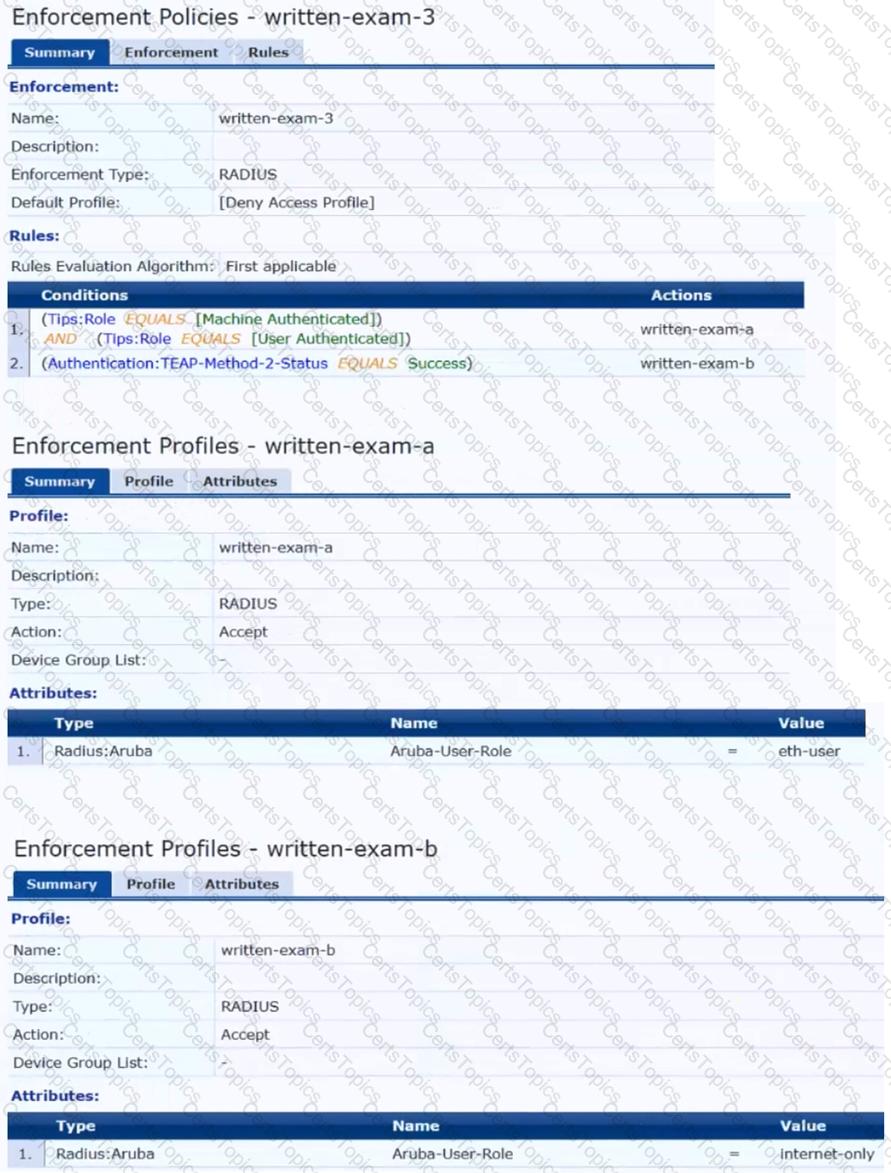
The gateway cluster has two gateways with these IP addresses:
• Gateway 1
o VLAN 4085 (system IP) = 10.20.4.21
o VLAN 20 (users) = 10.20.20.1
o VLAN 4094 (WAN) = 198.51.100.14
• Gateway 2
o VLAN 4085 (system IP) = 10.20.4.22
o VLAN 20 (users) = 10.20.20.2
o VLAN 4094 (WAN) = 198.51.100.12
• VRRP on VLAN 20 = 10.20.20.254
The customer requires high availability for the tunnels between the switches and the gateway cluster. If one gateway falls, the other gateway should take over its tunnels. Also, the switch should be able to discover the gateway cluster regardless of whether one of the gateways is in the cluster.
What is one change that you should make to the solution?
Refer to the scenario.
This customer is enforcing 802.1X on AOS-CX switches to Aruba ClearPass Policy Manager (CPPM). The customer wants switches to download role settings from CPPM. The “reception-domain” role must have these settings:
— Assigns clients to VLAN 14 on switch 1, VLAN 24 on switch 2, and so on.
— Filters client traffic as follows:
— Clients are permitted full access to 10.1.5.0/24 and the Internet
— Clients are denied access to 10.1.0.0/16
The switch topology is shown here:
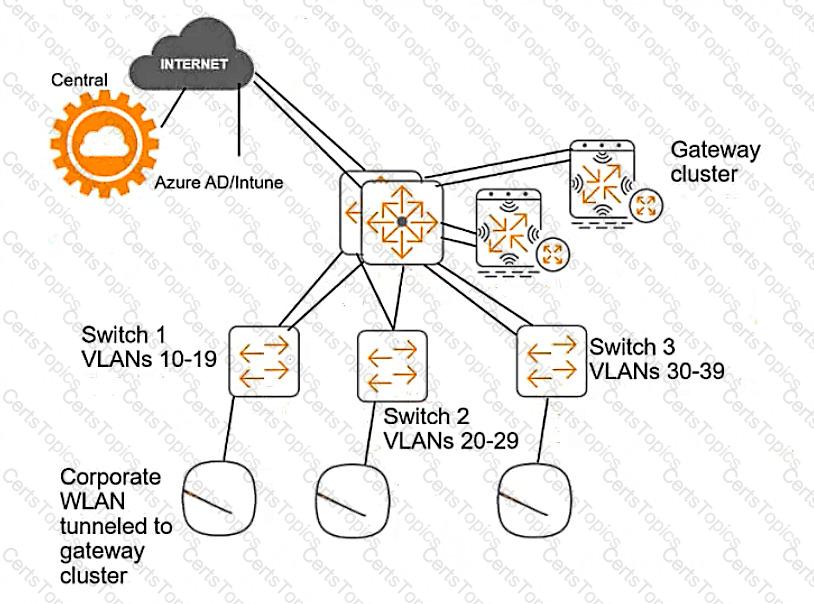
How should you configure the VLAN setting for the reception role?
Refer to the exhibit.
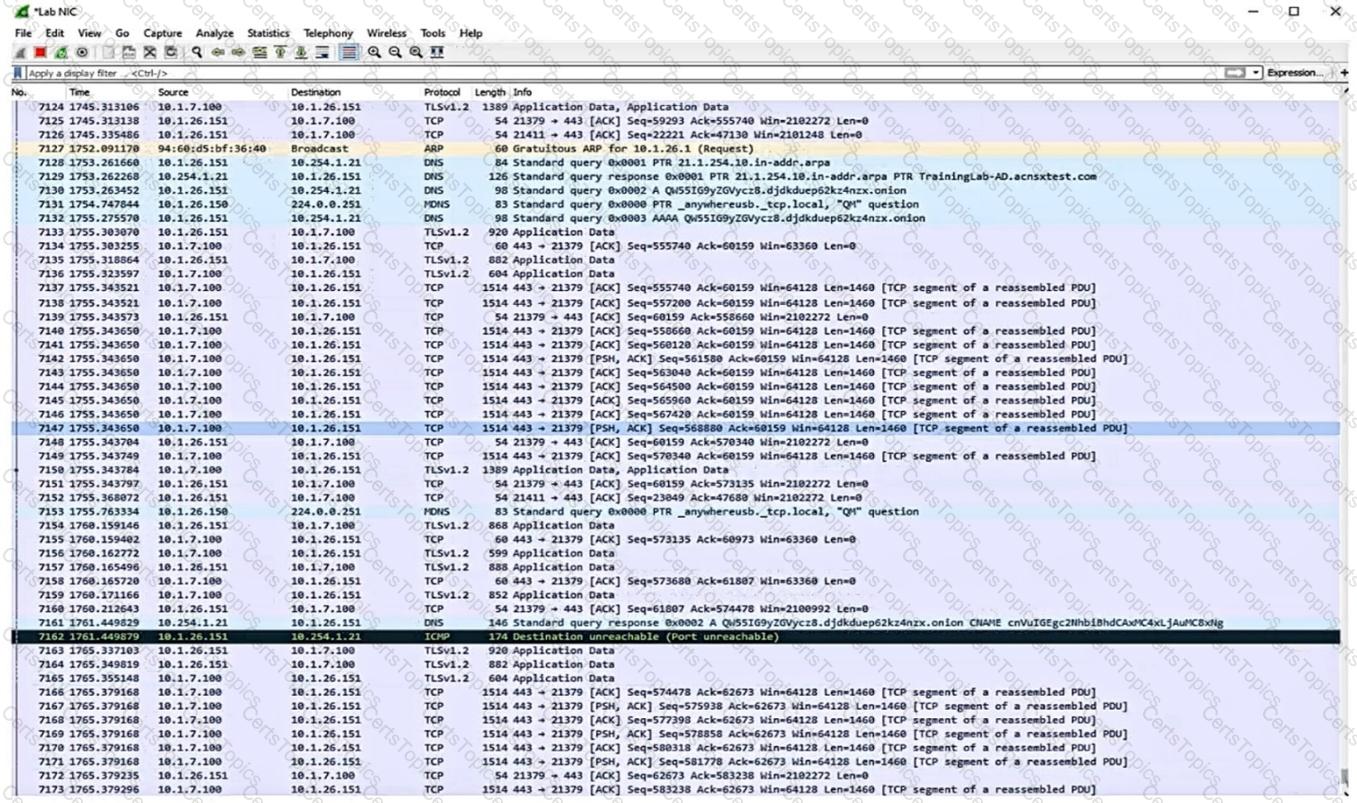
Which IP address should you record as a possibly compromised client?
Refer to the scenario.
# Introduction to the customer
You are helping a company add Aruba ClearPass to their network, which uses Aruba network infrastructure devices.
The company currently has a Windows domain and Windows CA. The Window CA issues certificates to domain computers, domain users, and servers such as domain controllers. An example of a certificate issued by the Windows CA is shown here.
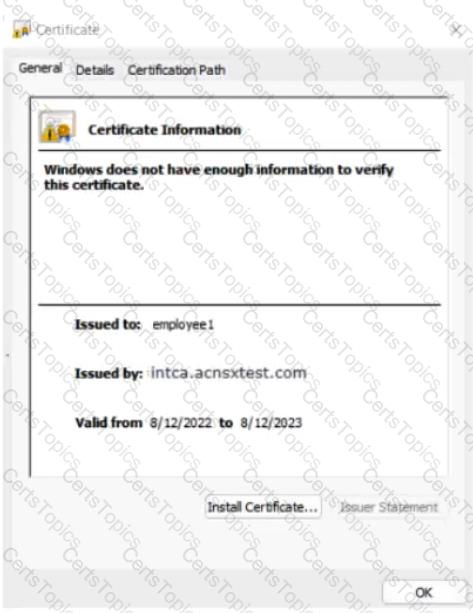
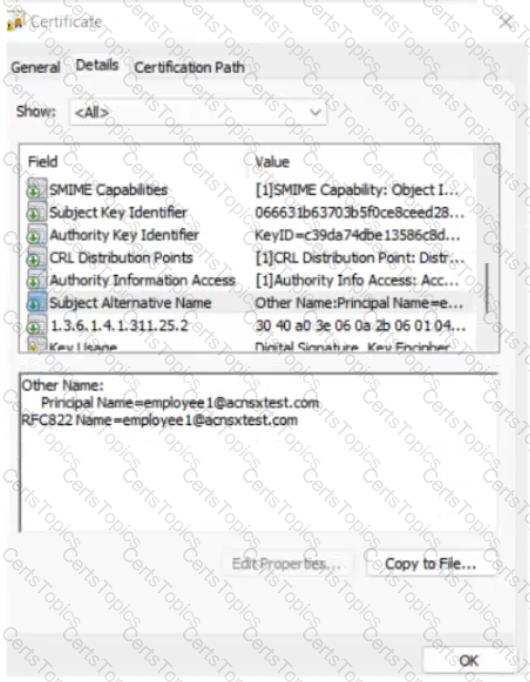
The company is in the process of adding Microsoft Endpoint Manager (Intune) to manage its mobile clients. The customer is maintaining the on-prem AD for now and uses Azure AD Connect to sync with Azure AD.
# Requirements for issuing certificates to mobile clients
The company wants to use ClearPass Onboard to deploy certificates automatically to mobile clients enrolled in Intune. During this process, Onboard should communicate with Azure AD to validate the clients. High availability should also be provided for this scenario; in other words, clients should be able to get certificates from Subscriber 2 if Subscriber 1 is down.
The Intune admins intend to create certificate profiles that include a UPN SAN with the UPN of the user who enrolled the device.
# Requirements for authenticating clients
The customer requires all types of clients to connect and authenticate on the same corporate SSID.
The company wants CPPM to use these authentication methods:
 EAP-TLS to authenticate users on mobile clients registered in Intune
EAP-TLS to authenticate users on mobile clients registered in Intune
 TEAR, with EAP-TLS as the inner method to authenticate Windows domain computers and the users on them
TEAR, with EAP-TLS as the inner method to authenticate Windows domain computers and the users on them
To succeed, EAP-TLS (standalone or as a TEAP method) clients must meet these requirements:
 Their certificate is valid and is not revoked, as validated by OCSP
Their certificate is valid and is not revoked, as validated by OCSP
 The client’s username matches an account in AD
The client’s username matches an account in AD
# Requirements for assigning clients to roles
After authentication, the customer wants the CPPM to assign clients to ClearPass roles based on the following rules:
 Clients with certificates issued by Onboard are assigned the “mobile-onboarded” role
Clients with certificates issued by Onboard are assigned the “mobile-onboarded” role
 Clients that have passed TEAP Method 1 are assigned the “domain-computer” role
Clients that have passed TEAP Method 1 are assigned the “domain-computer” role
 Clients in the AD group “Medical” are assigned the “medical-staff” role
Clients in the AD group “Medical” are assigned the “medical-staff” role
 Clients in the AD group “Reception” are assigned to the “reception-staff” role
Clients in the AD group “Reception” are assigned to the “reception-staff” role
The customer requires CPPM to assign authenticated clients to AOS firewall roles as follows:
 Assign medical staff on mobile-onboarded clients to the “medical-mobile” firewall role
Assign medical staff on mobile-onboarded clients to the “medical-mobile” firewall role
 Assign other mobile-onboarded clients to the “mobile-other” firewall role
Assign other mobile-onboarded clients to the “mobile-other” firewall role
 Assign medical staff on domain computers to the “medical-domain” firewall role
Assign medical staff on domain computers to the “medical-domain” firewall role
 All reception staff on domain computers to the “reception-domain” firewall role
All reception staff on domain computers to the “reception-domain” firewall role
 All domain computers with no valid user logged in to the “computer-only” firewall role
All domain computers with no valid user logged in to the “computer-only” firewall role
 Deny other clients access
Deny other clients access
# Other requirements
Communications between ClearPass servers and on-prem AD domain controllers must be encrypted.
# Network topology
For the network infrastructure, this customer has Aruba APs and Aruba gateways, which are managed by Central. APs use tunneled WLANs, which tunnel traffic to the gateway cluster. The customer also has AOS-CX switches that are not managed by Central at this point.
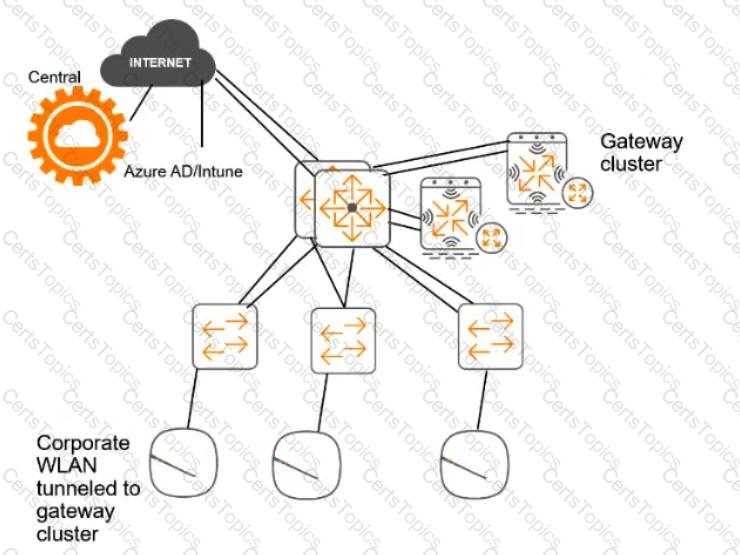
# ClearPass cluster IP addressing and hostnames
A customer’s ClearPass cluster has these IP addresses:
 Publisher = 10.47.47.5
Publisher = 10.47.47.5
 Subscriber 1 = 10.47.47.6
Subscriber 1 = 10.47.47.6
 Subscriber 2 = 10.47.47.7
Subscriber 2 = 10.47.47.7
 Virtual IP with Subscriber 1 and Subscriber 2 = 10.47.47.8
Virtual IP with Subscriber 1 and Subscriber 2 = 10.47.47.8
The customer’s DNS server has these entries
 cp.acnsxtest.com = 10.47.47.5
cp.acnsxtest.com = 10.47.47.5
 cps1.acnsxtest.com = 10.47.47.6
cps1.acnsxtest.com = 10.47.47.6
 cps2.acnsxtest.com = 10.47.47.7
cps2.acnsxtest.com = 10.47.47.7
 radius.acnsxtest.com = 10.47.47.8
radius.acnsxtest.com = 10.47.47.8
 onboard.acnsxtest.com = 10.47.47.8
onboard.acnsxtest.com = 10.47.47.8
You cannot see flow attributes for wireless clients.
What should you check?
Refer to the scenario.
A customer is using an AOS 10 architecture with Aruba APs and Aruba gateways (two per site). Admins have implemented auto-site clustering for gateways with the default gateway mode disabled. WLANs use tunneled mode to the gateways.
The WLAN security is WPA3-Enterprise with authentication to an Aruba ClearPass Policy Manager (CPPM) cluster VIP. RADIUS communications use RADIUS, not RadSec.
CPPM is using the service shown in the exhibits.
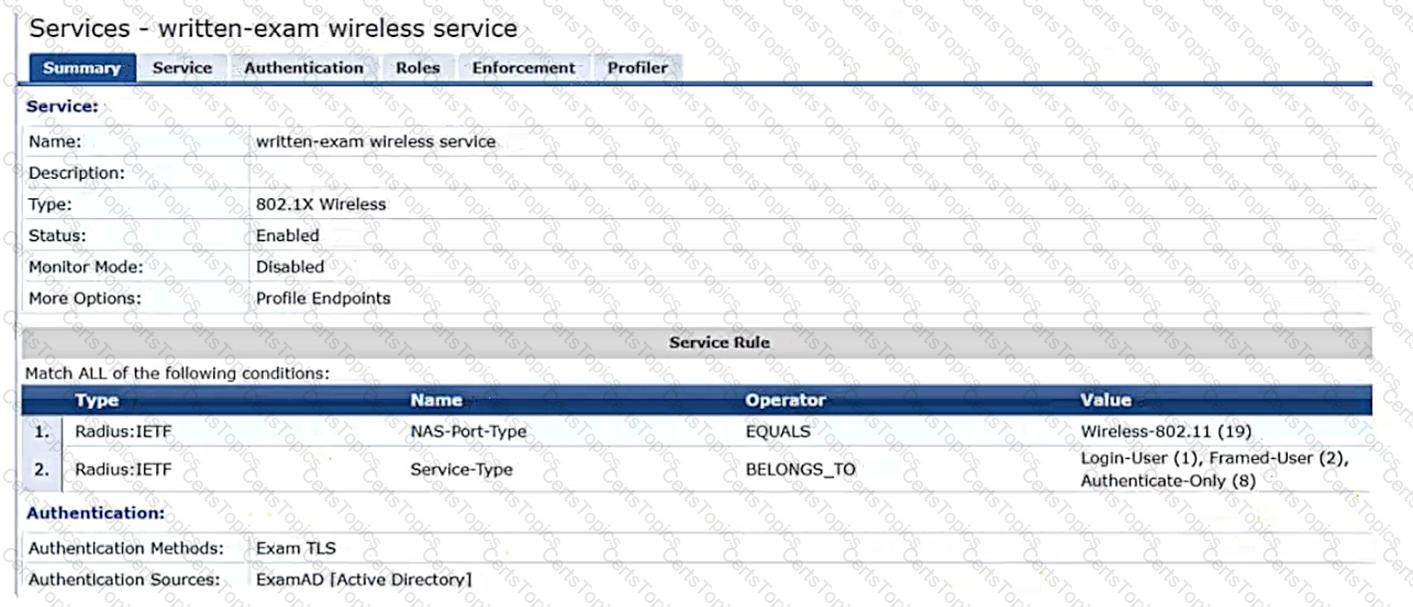
Which step can you take to improve operations during a possible gateway failover event?
The customer needs a way for users to enroll new wired clients in Intune. The clients should have limited access that only lets them enroll and receive certificates. You plan to set up these rights in an AOS-CX role named “provision.”
The customer’s security team dictates that you must limit these clients’ Internet access to only the necessary sites. Your switch software supports IPv4 and IPv6 addresses for the rules applied in the “provision” role.
What should you recommend?
You need to install a certificate on a standalone Aruba Mobility Controller (MC). The MC will need to use the certificate for the Web UI and for implementing RadSec with Aruba ClearPass Policy Manager. You have been given a certificate with these settings:
 Subject: CN=mc41.site94.example.com
Subject: CN=mc41.site94.example.com
 No SANs
No SANs
 Issuer: CN=ca41.example.com
Issuer: CN=ca41.example.com
 EKUs: Server Authentication, Client Authentication
EKUs: Server Authentication, Client Authentication
What issue does this certificate have for the purposes for which the certificate is intended?
You are configuring gateway IDS/IPS settings in Aruba Central.
For which reason would you set the Fail Strategy to Bypass?
Refer to the scenario.
# Introduction to the customer
You are helping a company add Aruba ClearPass to their network, which uses Aruba network infrastructure devices.
The company currently has a Windows domain and Windows CA. The Window CA issues certificates to domain computers, domain users, and servers such as domain controllers. An example of a certificate issued by the Windows CA is shown here.
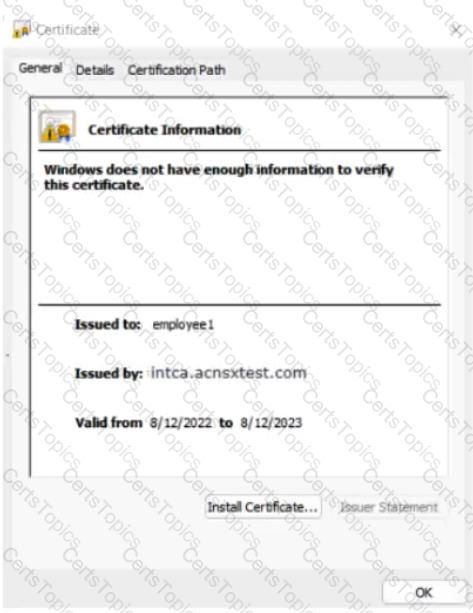
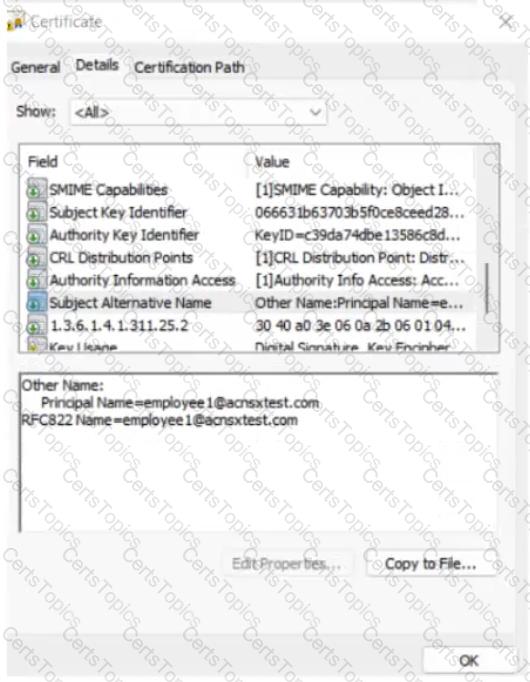
The company is in the process of adding Microsoft Endpoint Manager (Intune) to manage its mobile clients. The customer is maintaining the on-prem AD for now and uses Azure AD Connect to sync with Azure AD.
# Requirements for issuing certificates to mobile clients
The company wants to use ClearPass Onboard to deploy certificates automatically to mobile clients enrolled in Intune. During this process, Onboard should communicate with Azure AD to validate the clients. High availability should also be provided for this scenario; in other words, clients should be able to get certificates from Subscriber 2 if Subscriber 1 is down.
The Intune admins intend to create certificate profiles that include a UPN SAN with the UPN of the user who enrolled the device.
# Requirements for authenticating clients
The customer requires all types of clients to connect and authenticate on the same corporate SSID.
The company wants CPPM to use these authentication methods:
 EAP-TLS to authenticate users on mobile clients registered in Intune
EAP-TLS to authenticate users on mobile clients registered in Intune
 TEAR, with EAP-TLS as the inner method to authenticate Windows domain computers and the users on them
TEAR, with EAP-TLS as the inner method to authenticate Windows domain computers and the users on them
To succeed, EAP-TLS (standalone or as a TEAP method) clients must meet these requirements:
 Their certificate is valid and is not revoked, as validated by OCSP
Their certificate is valid and is not revoked, as validated by OCSP
 The client’s username matches an account in AD
The client’s username matches an account in AD
# Requirements for assigning clients to roles
After authentication, the customer wants the CPPM to assign clients to ClearPass roles based on the following rules:
 Clients with certificates issued by Onboard are assigned the “mobile-onboarded” role
Clients with certificates issued by Onboard are assigned the “mobile-onboarded” role
 Clients that have passed TEAP Method 1 are assigned the “domain-computer” role
Clients that have passed TEAP Method 1 are assigned the “domain-computer” role
 Clients in the AD group “Medical” are assigned the “medical-staff” role
Clients in the AD group “Medical” are assigned the “medical-staff” role
 Clients in the AD group “Reception” are assigned to the “reception-staff” role
Clients in the AD group “Reception” are assigned to the “reception-staff” role
The customer requires CPPM to assign authenticated clients to AOS firewall roles as follows:
 Assign medical staff on mobile-onboarded clients to the “medical-mobile” firewall role
Assign medical staff on mobile-onboarded clients to the “medical-mobile” firewall role
 Assign other mobile-onboarded clients to the “mobile-other” firewall role
Assign other mobile-onboarded clients to the “mobile-other” firewall role
 Assign medical staff on domain computers to the “medical-domain” firewall role
Assign medical staff on domain computers to the “medical-domain” firewall role
 All reception staff on domain computers to the “reception-domain” firewall role
All reception staff on domain computers to the “reception-domain” firewall role
 All domain computers with no valid user logged in to the “computer-only” firewall role
All domain computers with no valid user logged in to the “computer-only” firewall role
 Deny other clients access
Deny other clients access
# Other requirements
Communications between ClearPass servers and on-prem AD domain controllers must be encrypted.
# Network topology
For the network infrastructure, this customer has Aruba APs and Aruba gateways, which are managed by Central. APs use tunneled WLANs, which tunnel traffic to the gateway cluster. The customer also has AOS-CX switches that are not managed by Central at this point.

# ClearPass cluster IP addressing and hostnames
A customer’s ClearPass cluster has these IP addresses:
 Publisher = 10.47.47.5
Publisher = 10.47.47.5
 Subscriber 1 = 10.47.47.6
Subscriber 1 = 10.47.47.6
 Subscriber 2 = 10.47.47.7
Subscriber 2 = 10.47.47.7
 Virtual IP with Subscriber 1 and Subscriber 2 = 10.47.47.8
Virtual IP with Subscriber 1 and Subscriber 2 = 10.47.47.8
The customer’s DNS server has these entries
 cp.acnsxtest.com = 10.47.47.5
cp.acnsxtest.com = 10.47.47.5
 cps1.acnsxtest.com = 10.47.47.6
cps1.acnsxtest.com = 10.47.47.6
 cps2.acnsxtest.com = 10.47.47.7
cps2.acnsxtest.com = 10.47.47.7
 radius.acnsxtest.com = 10.47.47.8
radius.acnsxtest.com = 10.47.47.8
 onboard.acnsxtest.com = 10.47.47.8
onboard.acnsxtest.com = 10.47.47.8
The customer needs a secure way for users to enroll their new wireless clients in Intune. You are recommending a new WLAN that will provide the users with limited access for the enrollment.
You have set up captive portal for clients on this WLAN to a web page with instructions for enrolling devices. You will need to add several hostnames to the captive portal allowlist manually.
What is one of those hostnames?
How does Aruba Central handle security for site-to-site connections between AOS 10 gateways?
Refer to the scenario.
An organization wants the AOS-CX switch to trigger an alert if its RADIUS server (cp.acnsxtest.local) rejects an unusual number of client authentication requests per hour. After some discussions with other Aruba admins, you are still not sure how many rejections are usual or unusual. You expect that the value could be different on each switch.
You are helping the developer understand how to develop an NAE script for this use case.
You are helping the developer find the right URI for the monitor.
Refer to the exhibit.
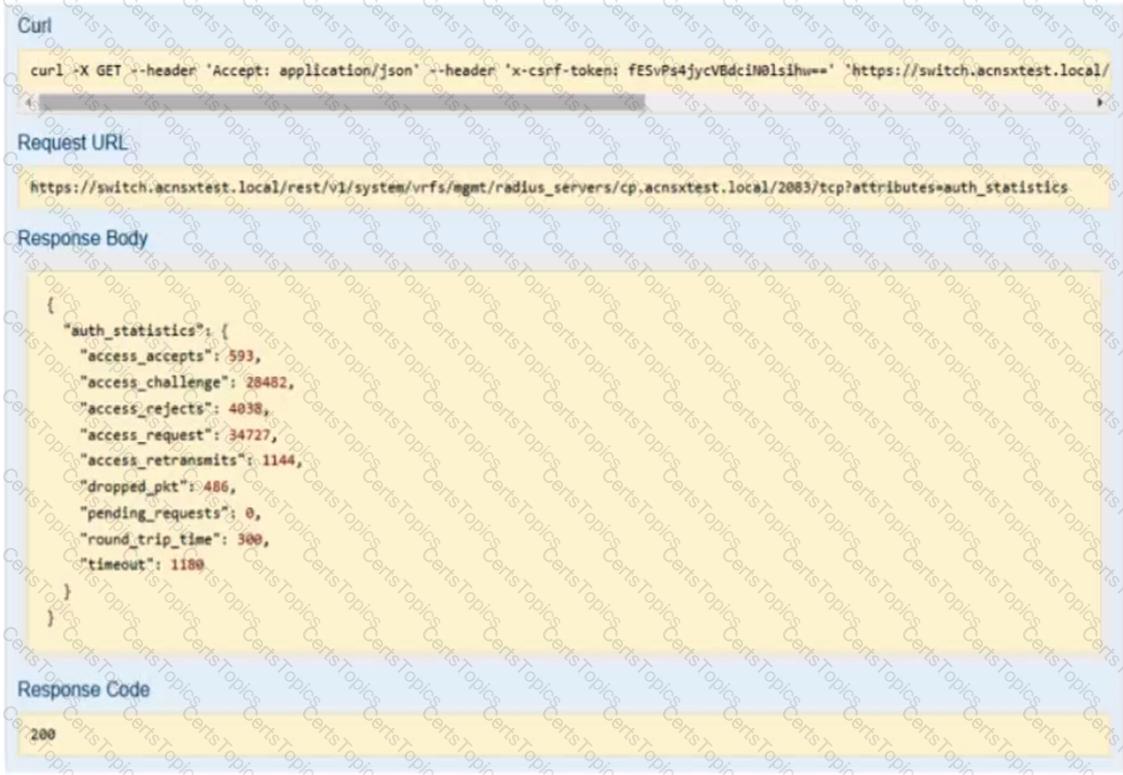
You have used the REST API reference interface to submit a test call. The results are shown in the exhibit.
Which URI should you give to the developer?
Refer to the scenario.
A customer has an Aruba ClearPass cluster. The customer has AOS-CX switches that implement 802.1X authentication to ClearPass Policy Manager (CPPM).
Switches are using local port-access policies.
The customer wants to start tunneling wired clients that pass user authentication only to an Aruba gateway cluster. The gateway cluster should assign these clients to the “eth-internet" role. The gateway should also handle assigning clients to their VLAN, which is VLAN 20.
The plan for the enforcement policy and profiles is shown below:
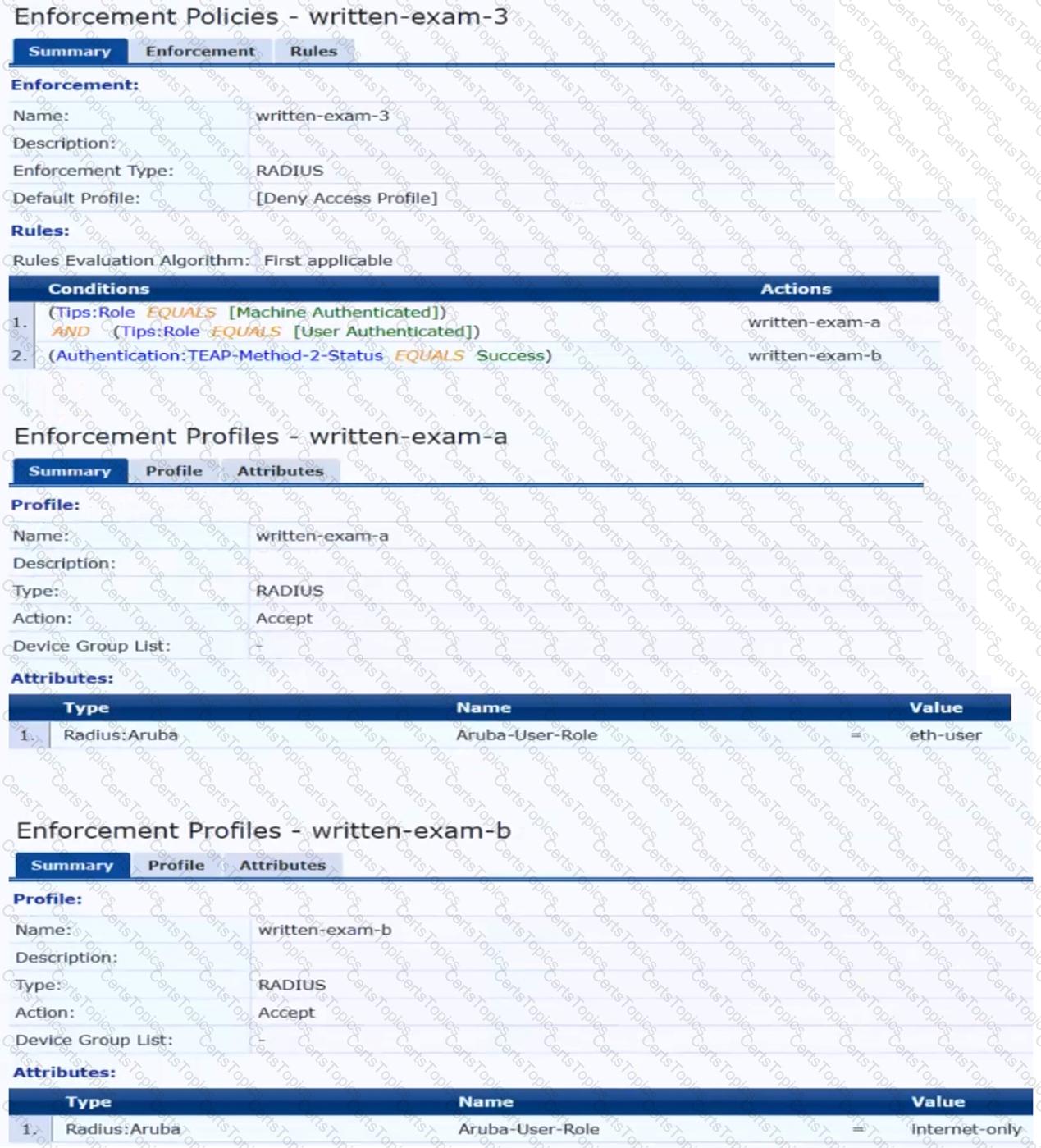
The gateway cluster has two gateways with these IP addresses:
• Gateway 1
o VLAN 4085 (system IP) = 10.20.4.21
o VLAN 20 (users) = 10.20.20.1
o VLAN 4094 (WAN) = 198.51.100.14
• Gateway 2
o VLAN 4085 (system IP) = 10.20.4.22
o VLAN 20 (users) = 10.20.20.2
o VLAN 4094 (WAN) = 198.51.100.12
• VRRP on VLAN 20 = 10.20.20.254
The customer requires high availability for the tunnels between the switches and the gateway cluster. If one gateway falls, the other gateway should take over its tunnels. Also, the switch should be able to discover the gateway cluster regardless of whether one of the gateways is in the cluster.
You are setting up the UBT zone on an AOS-CX switch.
Which IP addresses should you define in the zone?